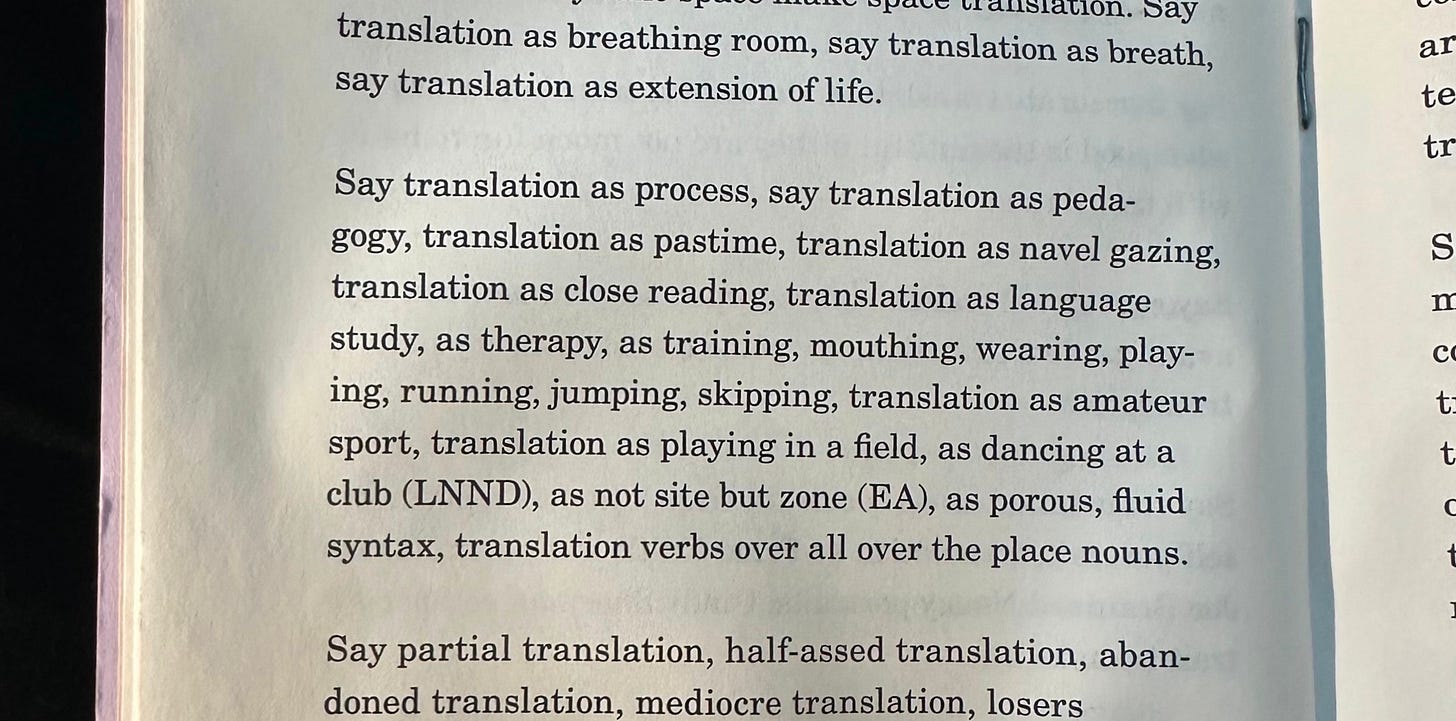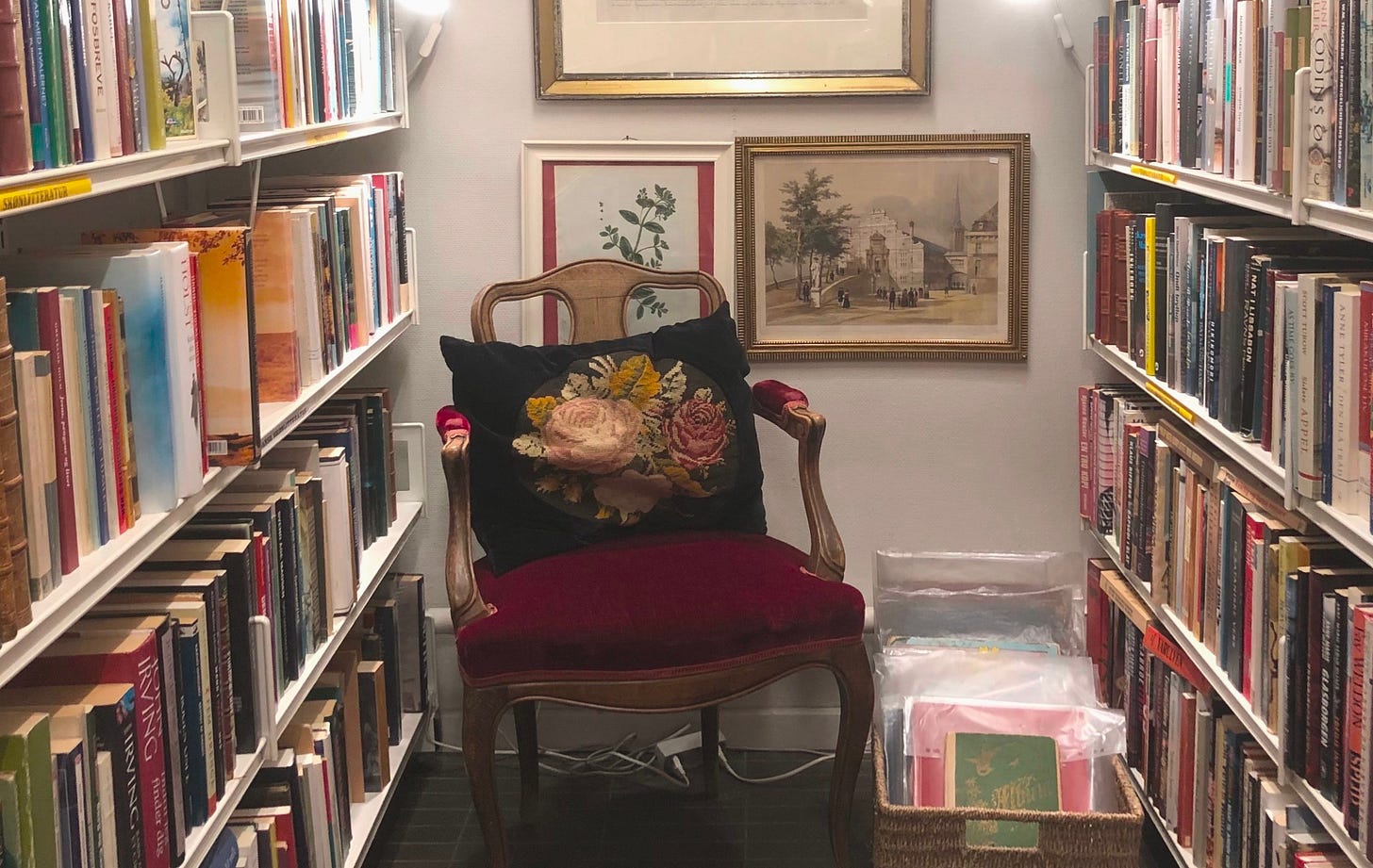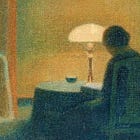On "translator completionism" & seeking syllabi for your reading
Why not let your favorite translators curate your reading list?
Regan’s newsletter publishes book recommendations on a theme and the occasional essay. Past newsletters have covered the 5+ Club, the Cure for Autofiction, Women in Translation, and more.
I. On deciding what we read and when
Two things (of many) have been on my mind recently: First, I’m thinking a lot about what influences who I read and when. How do I decide what to read next (how does anyone)? Second is the question of translator visibility: How can I do a better job noticing and appreciating translators and their work?
This first question is likely a product of being back in academia; ninety percent of my reading this semester has been dictated by a handful of (very incredible) syllabi. But honestly, I feel like the question of who we read and how and when has been a topic on my mind since my first newsletter last spring. I’ve always been interested in the tangents readers follow when it comes to curating their readings lists, checking out their next books from the library, or deciding when to finally pick up a novel that’s been waiting on their shelf.
Maybe you’re influenced by the NYT’s Best of the Century list, or by recommendations from a friend, or by celebrity book club picks; maybe you read through the Booker Prize longlists, feel pulled to pick up authors who have won a Pulitzer, or make decisions based on a fuzzy preconception of “classics everyone should read.” I love that
dedicates certain months to specific authors’ works, or that she’s currently reading through a “19th century wives under pressure” project, which includes Anna Karenina, Middlemarch and more.I first thought to direct my own reading early in high school.1 Every month, I aimed to read, at a minimum, one “classic,” one work of non-fiction, and one work in translation, beyond which I could read anything I was in the mood for. I stuck to that system for a few years, and my reading goals since have fluctuated with different periods of my life.
Last fall, for example, I was thinking a lot about “author completionism” and the journey of following a writer’s oeuvre as one type of “scaffolding” that helps me to be intentional about deciding what to read, or helps me at least to notice who I’m reading and gravitating toward—an idea that’s led me to this newsletter.

II. “Translator fingerprints,” or translator as curator
In my graduate program, I’m studying literary translation alongside fiction. I’ve always enjoyed reading work in translation2, but I’ve been feeling especially energized recently by engaging with my peers’ translations-in-progress in our workshops and discussing published translations more critically in seminar.
It was a beginning-of-class discussion prompt from my professor3 that led me to begin thinking about translators not only as writers in their own right, but as curators of a sort, too. We had read and discussed two very different works in translation the previous week: Julia Wong Kcomt’s poetry collection A Blind Salmon and Augusto Higa Oshiro’s novel The Enlightenment of Katzuo Nakamatsu, both translated from the Spanish by Jennifer Shyue.
The question posed to us was whether we could see something of Shyue carried across each work, a translator’s “fingerprints.” Stylistically, there’s a commitment to rhythm and propulsion in both, despite the differences between Kcomt’s fiery enjambment and Oshiro’s tumbling, many-clause sentences. There’s also a clear attention to recurring motifs and phrases that echo across each work.4
Beyond stylistic “fingerprints,” the two translations of Shyue’s have thematic, cross-cultural connections. Julia Wong Kcomt is a Chinese Peruvian poet whose work in this collection moves between countries and cultures: from Lima to Berlin, Buenos Aires, Chepén, Tijuana, and Vienna; Augusto Higa Oshiro was born in Lima to Japanese immigrant parents, and The Enlightenment of Katzuo Nakamatsu follows a Peruvian former professor of Japanese descent wandering through his city while grappling with the loss of his job and pressures of assimilation.
Just as interesting as the translations themselves were the stories behind Shyue’s discovery of and relationships with both writers, which she’s written about in her afterwords or spoken of in interviews. After reading, I wasn’t only curious about who Shyue would translate next, but about the many translators whose work I’ve already read across authors. How have they built their own niche “syllabi” of writers they’ve found important or moving or compelling enough to translate?5
III. Translator completionism: Setting up the system
I thought: Why not follow a translator’s work the way I follow a favorite author’s?
There’s a zeitgeist-y, burgeoning idea of “celebrity translators.” Emily Wilson comes to mind right away, and her translations of The Odyssey and Iliad. I’m thinking of the way the name of a certain translator can be a type of shorthand for the genre or theme of a book, too: Megan McDowell cues feminist, Latin-American horror; Anton Hur is the face of oft-surrealist South Korean fiction; Ann Goldstein signifies the atmospheric, literary likes of Elena Ferrante and Natalia Ginzburg.
But what if I moved beyond the bigger names and mapped all the translators I’ve read—who might I discover that I already gravitate toward naturally?
I’ve read just over 150 works in translation.6 The first thing I did to start setting up my “translator completionism” system was sift through my Goodreads shelf of translated lit from top to bottom; for every book, I wrote down the translator’s name (organized under the language from which they translate) as well as the title and author.7 I’ll continue adding to this Notion page with every new translation I read.
From here, I went through and highlighted in yellow all the translators from whom I’ve read more than one book. This brought all 117 translators I’ve read down to just 22 whom I’ve read more than once. To prevent double-counting, I highlighted the translators from whom I’ve read works translated from different languages in green.8
These 22 translators I’ve read more than once seemed to fall into one of a few categories:
They translate my most-read authors
Alison L. Strayer and Tanya Leslie both translate Annie Ernaux
Ted Goossen and Philip Gabriel translate Haruki Murakami
Don Bartlett and Ingvild Burkey translate Knausgaard
They’re borderline canonical
Richard Lattimore’s translations from Ancient Greek
Pevear & Volokhonsky’s Tolstoy and Dostoevsky
Edwin and Willa Muir’s Kafka translations
They’re closely linked to an author I’ve read more than once
Monica Cure x Liliana Corobca
Charlotte Barslund x Vigdis Hjorth
Margaret Mitsutani x Yoko Tawada
They’re “big-name” translators I already knew I love reading
Susan Bernofsky’s translations of Jenny Erpenbeck, Yoko Tawada, Robert Walser
Ann Goldstein’s Elena Ferrante and Italo Calvino
Megan McDowell’s Mariana Enríquez, Samanta Schweblin, and Alejandro Zambra
Which leaves me with…
IV. Translator completionism: First steps
When I had the idea for this newsletter, I knew I wanted to come away with a few specific translators whose “syllabi” of translations I could try and tackle. The three I’ve landed on to start with are:
Jennifer Shyue (Spanish)
—I’ve read: Mentioned above, Julia Wong Kcomt’s poetry collection A Blind Salmon and Augusto Higa Oshiro’s novel The Enlightenment of Katzuo Nakamatsu
—Next up: Venezuelan reporter Paula Ramón’s memoir, Motherland, and poetry chapbook Vice-royal-ties by Julia Wong Kcomt
Emma Ramadan (French)
—I’ve read: Marguerite Duras’ second novel, originally published in 1946, called The Easy Life (co-translated with Olivia Baes) and Anne Garréta’s experimental, genderless romance Sphinx, published in 1986
—Next up: A darkly funny contemporary debut, My Husband by Maud Ventura, and a “nightmarish” story collection from the ‘60s, Panics by Barbara Molinard
Isabel Fargo Cole (German)
—I’ve read: Dark and surrealist GDR-era writer Wolfgang Hilbig’s story collections Under the Neomoon and The Sleep of the Righteous
—Next up: “Recently rediscovered” 19th-century Austrian writer Adalbert Stifter’s Motley Stones, and All the Roads are Open by Annemarie Schwarzenbach, the memoir of two Swiss writers fleeing Europe in 1939 and traveling along Afghanistan’s Northern Road
Thank you for sticking around to the end of the newsletter! I had a lot of fun putting it together and would love to hear whether you have a favorite translator, how you approach reading in translation, what your process is like when it comes to selecting the books you’ll read next, and so on, so forth!
If you’re looking for more in the meantime, here are a few newsletters I’ve really enjoyed recently…
Woman as Dog //
’s sharp piece of cultural criticism on women’s “re-domestication in the media.” Think Babygirl, All Fours…Josephine’s Room // a very beautiful reflection on writing and environment by
back brain writing // the first post I encountered of
’s, an immediate subscribeIn the Attempt, Succeeding // an earnest, inspiring review of Ron Padgett’s poetry by
: “To pay attention is eventually to delight, and one cannot be stuck when one is delighted.”
ie. deep in my Young Adult fantasy & sci-fi era
My three August/Sept newsletters focused on translated works, including:
The one and only Julia Sanches! Who also loaned our class her copy of Say Translation is Art (from which I pulled this newsletter’s title), which has been moving between us sisterhood-of-the-traveling-pants style
In her translator’s note to The Enlightenment, Shyue describes the “breathlessness” of translating, especially the distinct rhythms of Augusto’s sentences, which in this novel “are elliptical, often anaphoric, building to a swaying rhythm that slips by like silk and is likewise slippery to pin down in a new language.” She writes: “When I translate poetry, the sensation [of translating] is akin to bringing the page very close to my face so I can look extra hard at the words, and I often had that feeling when translating this novel, even though it is not, technically, poetry.”
Quick disclaimer to keep in mind: when I spoke with the wonderful Lucy Jones, who translates from the German, for a brief interview last year, she reminded me that for many/most career translators, choosing who/what you’re able to translate is often the exception, not the rule
I’ve been keeping track of all the books I read since 6th grade—in Moleskine’s analog Book Journal for the first few years, until I made a Goodreads in early high school and backlogged everything to have it all in one spot
I have a loose practice of checking off countries from an “every country in the world” master list when I read a novel from somewhere new, but this was the first time I’ve mapped out how many novels I’ve read from various languages! The results were unsurprising sometimes (German takes the lead), and very surprising other times (I’ve read more books from the Serbo-Croatian than Korean?!). Thinking about writing a newsletter that dives into these stats & revelations a bit more
Just two offenders here: Michael Henry Heim’s translation of Kundera from the Czech and translation of Mann’s Death in Venice from the German; and Allen Mandelbaum’s Virgil’s Aeneid from the Latin and his translation of Dante’s Inferno from the Italian











I LOVE THIS. I didn't start paying attention to translators until I kept recognizing Megan McDowell's name and then also when I was searching for a digital copy of Crime and Punishment. Sara Hildreth talked about loving a certain editors work and I think that falls in with this idea too. Now I want to go track mine....
I like this project Regan and I look forward to more of your updates! I haven’t been following any translators but if I want to read classic Russian lit I make sure I get the Pevear and Volokhonsky translations.